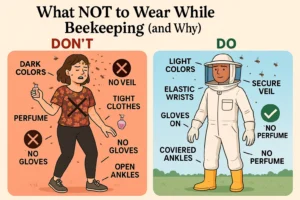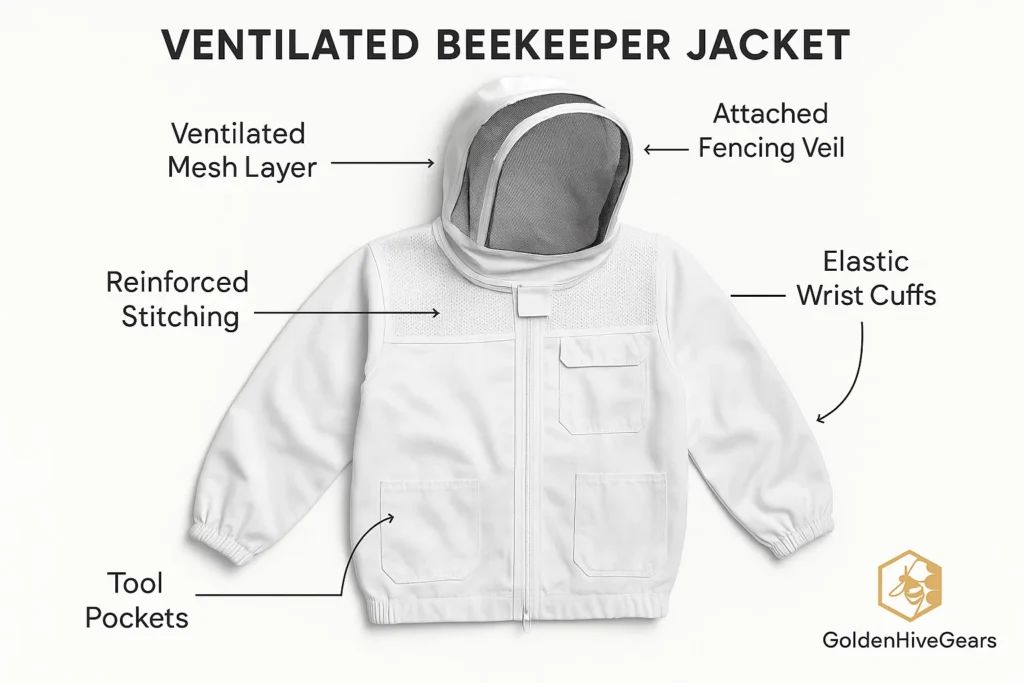
🐝 Gear Up. Stay Safe. Protect the Hive. 🌼
A beekeeper walks through rows of buzzing hives under the summer sun, donning a white ventilated beekeeper jacket with a mesh veil zipped securely around the face. Their arms move confidently, lifting frames and inspecting combs — protected but unrestricted.
Whether you’re a seasoned apiarist or just beginning your journey into beekeeping, the beekeeper jacket offers an ideal balance of mobility, breathability, and protection. While full suits provide full-body coverage, jackets are the go-to option for quick inspections, small tasks, or hot-weather beekeeping.
In this guide, we’ll explore everything you need to know about beekeeper jackets — what they are, why they’re useful, what features to look for, and how to choose the right one for your apiary.

What Is a Beekeeper Jacket?
A beekeeper jacket is a lightweight protective garment worn by beekeepers from the waist up. It typically includes:
Unlike a full bee suit, which covers the entire body, a beekeeper jacket is paired with jeans or work pants, making it quicker and easier to put on for routine hive tasks.
Why Choose a Beekeeper Jacket?
Many beekeepers prefer jackets for day-to-day hive visits due to their flexibility and convenience. Here’s why:
Putting on a full bee suit takes time. Jackets, on the other hand, slip on quickly — perfect for short inspections, hive feedings, or checking supers.
Jackets are less bulky, allowing for easier movement of arms, shoulders, and torso. This is especially useful in tight apiary spaces or mobile setups.
Ventilated jackets provide airflow that keeps you cooler during warm months. Since they only cover half your body, they reduce heat retention significantly.
Bee jackets are usually less expensive than full suits, making them a great starting point for beginners or backup gear for professionals.
When to Use a Beekeeper Jacket Instead of a Full Suit
Although full suits offer maximum protection, jackets are ideal for:
However, if you’re working with aggressive bees, removing swarms, or dealing with unknown hives, a full suit is recommended for full-body protection.
Key Features to Look for in a Beekeeper Jacket
Choosing the right beekeeper jacket ensures comfort and safety. Here’s what to look for:
Multiple pockets are handy for carrying hive tools, brushes, or queen markers. Some jackets include inner pockets for added security.
Are Beekeeper Jackets Sting-Proof?
Beekeeper jackets are sting-resistant, not 100% sting-proof. The level of protection depends on:
Ventilated jackets with multi-layer mesh construction offer the best defense. If a bee lands on your back or arms, they’re far less likely to reach your skin.

For added safety, always wear sturdy jeans, gloves, and boots when using a jacket instead of a full suit.
Maintenance Tips for Your Beekeeper Jacket
To keep your jacket effective and long-lasting:
With proper care, a high-quality beekeeper jacket can last for several seasons.
Why GoldenHiveGears Beekeeper Jackets Stand Out
At GoldenHiveGears, our beekeeper jackets are designed for beekeepers who value comfort, durability, and protection — all without the bulk of a full suit.
Whether you’re checking hives in your backyard or managing a commercial apiary, GoldenHiveGears jackets offer a reliable, breathable option for fast, safe beekeeping.
Final Thoughts: Is a Beekeeper Jacket Right for You?
If you’re seeking a convenient, breathable, and protective solution for daily beekeeping tasks, a beekeeper jacket might be your best companion. It allows you to work comfortably without compromising safety, especially in warmer climates or when managing calm colonies.
While full suits remain essential for high-risk jobs, a high-quality bee jacket is a valuable addition to any beekeeper’s gear set.
🛒 Ready to upgrade your beekeeping gear?
Explore our full range of GoldenHiveGears beekeeper jackets today and experience lightweight protection designed by beekeepers — for beekeepers.
